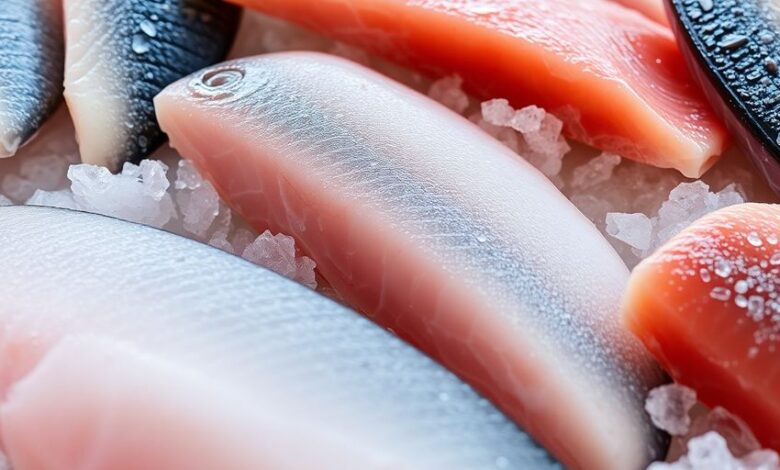Are All Frozen Fish Injected with Phosphates?

Frozen fish is a popular choice for many households, but there’s a lot of confusion about what’s really in it. One common question is whether all frozen fish is treated with phosphates. This article will explore what phosphates are, how they’re used, and what effects they have on fish quality. We’ll also look at health concerns, alternatives, and what consumers should know before making a purchase.
Key Takeaways
- Not all frozen fish is injected with phosphates, but many commercial products are.
- Phosphates help retain moisture, improve color, and extend shelf life of fish.
- There are different methods for adding phosphates, including industrial techniques.
- Health concerns exist, but regulations help ensure safety in food products.
- Consumers are increasingly interested in natural alternatives to phosphate-treated fish.
Understanding Phosphates in Frozen Fish

What Are Phosphates?
Phosphates are chemical compounds that contain phosphorus. They are often used in food processing to improve texture and preserve freshness. Phosphates help retain moisture in frozen fish, making it more appealing to consumers.
Common Types of Phosphates Used
There are several types of phosphates commonly used in frozen fish:
- Sodium tripolyphosphate (STPP): Often used for its moisture-retaining properties.
- Tetrasodium pyrophosphate (TSPP): Helps improve texture and shelf life.
- Sodium hexametaphosphate: Used for its ability to prevent discoloration.
| Type of Phosphate | Purpose |
|---|---|
| STPP | Moisture retention |
| TSPP | Texture improvement |
| Sodium hexametaphosphate | Prevents discoloration |
Why Are Phosphates Added to Frozen Fish?
Phosphates are added to frozen fish for several reasons:
- Moisture retention: They help keep the fish juicy during freezing and thawing.
- Texture improvement: Phosphates can make fish fillets firmer and more appealing.
- Shelf life extension: They help prevent spoilage, allowing fish to stay fresh longer.
Phosphates play a crucial role in maintaining the quality of frozen fish, ensuring it remains tasty and safe for consumption.
By understanding the role of phosphates, consumers can make informed choices about the frozen fish they purchase.
The Process of Injecting Phosphates into Frozen Fish
Methods of Injection
Injecting phosphates into frozen fish is a common practice in the food industry. The main methods include:
- Brine Injection: This involves injecting a salt and phosphate solution directly into the fish fillets.
- Soaking: Fish can be soaked in a phosphate solution before freezing.
- Dipping: Fish fillets are dipped in a phosphate solution to enhance their quality.
Industrial vs. Traditional Methods
The methods used for injecting phosphates can vary significantly:
- Industrial Methods: These are more efficient and often involve machinery for brine injection. They allow for consistent quality and faster processing.
- Traditional Methods: These include layering fish with salt and phosphate in containers, which can take longer but may be preferred for certain types of fish.
Impact on Fish Quality
Phosphate injection can significantly improve the quality of frozen fish. Here are some key effects:
- Color and Appearance: Fish treated with phosphates often have a brighter, more appealing color.
- Texture and Firmness: Phosphates help retain moisture, making the fish firmer and less likely to dry out.
- Shelf Life Extension: Fish treated with phosphates can last longer in storage, reducing waste and improving profitability.
The use of phosphates in fish processing not only enhances quality but also meets consumer demand for fresher products.
Effects of Phosphate Injection on Fish Quality

Color and Appearance
Phosphate injection can significantly enhance the color and appearance of frozen fish. Fish treated with phosphates often appear:
- Brighter and more appealing
- Less prone to discoloration during storage
- More uniform in color, which can attract consumers
Texture and Firmness
The texture of fish can also be improved through phosphate injection. Key benefits include:
- Increased firmness of the fish fillets
- Better water retention, leading to juicier fish
- Reduced cooking loss, which helps maintain quality during preparation
Shelf Life Extension
Phosphates play a crucial role in extending the shelf life of frozen fish. They help by:
- Reducing oxidation, which can spoil fish
- Minimizing drip loss during thawing, keeping the fish moist
- Enhancing overall quality, making it more appealing to consumers
Phosphate treatment not only improves the visual appeal of fish but also enhances its texture and longevity, making it a popular choice in the seafood industry.
| Quality Aspect | Effect of Phosphate Injection |
|---|---|
| Color | Brighter, less discoloration |
| Texture | Firmer, better water retention |
| Shelf Life | Extended, reduced spoilage |
Health and Safety Concerns
Potential Health Risks
The use of phosphates in frozen fish raises some health concerns. While phosphates can help preserve fish, they may also lead to:
- Increased sodium intake
- Potential allergic reactions
- Concerns about long-term health effects
Regulations and Standards
To ensure safety, various regulations govern the use of phosphates in food products. These include:
- FDA guidelines on food additives
- Limits on phosphate levels in seafood
- Regular inspections of processing facilities
Consumer Awareness
It’s important for consumers to be informed about what they eat. Here are some ways to stay aware:
- Read labels carefully for phosphate content
- Research brands and their practices
- Ask questions at the seafood counter
Understanding the implications of phosphate use in frozen fish can help consumers make better choices for their health and safety.
Alternatives to Phosphate Injection
Natural Preservatives
Natural preservatives are becoming popular as alternatives to phosphates. Some common options include:
- Salt: A traditional method that helps in preserving fish by drawing out moisture.
- Vinegar: Acts as a natural acid that can inhibit bacterial growth.
- Lemon Juice: Contains citric acid, which can help in preserving freshness.
Modified Atmosphere Packaging
This method involves altering the atmosphere around the fish to extend its shelf life. Key points include:
- Reduced Oxygen Levels: Lowering oxygen can slow down spoilage.
- Increased Carbon Dioxide: Helps in reducing microbial growth.
- Longer Shelf Life: Fish can stay fresh for a longer time without phosphates.
Consumer Preferences
Many consumers are now looking for fish products without added phosphates. This shift is driven by:
- Health Concerns: Awareness of potential health risks associated with phosphates.
- Desire for Natural Products: A growing trend towards natural and organic foods.
- Taste Preferences: Some believe that fish without phosphates tastes better.
The demand for natural alternatives is reshaping the fish market, encouraging producers to explore healthier options.
In summary, while phosphates have been widely used in the fish industry, there are effective alternatives that can maintain quality and meet consumer demands.
Market Trends and Consumer Preferences

Demand for Phosphate-Treated Fish
The market for frozen fish is growing rapidly. In 2023, the fish market was valued at $732.87 billion, and it is expected to grow at a rate of 3.4% annually until 2032. This growth is partly due to the increasing demand for phosphate-treated fish, which many consumers believe enhances quality and shelf life.
Regional Differences
Consumer preferences vary by region. For example:
- In Spain, there is a strong preference for whiter and thicker fillets.
- Portugal still favors traditional dried salted cod products.
- In Brazil, convenience products like desalted cod are becoming more popular.
Future Outlook
As consumers become more health-conscious, the trend is shifting towards natural alternatives. Many are looking for fish products that are free from additives like phosphates. This shift may lead to a decline in phosphate-treated fish in the future.
The fish market is evolving, and consumer preferences are driving changes in how fish is processed and preserved.
Overall, understanding these trends is crucial for producers and retailers to meet consumer demands effectively.
Regulatory and Industry Perspectives
Current Regulations
The use of phosphates in frozen fish is regulated to ensure safety and quality. Key regulations include:
- EU Regulation 1129/2011: Establishes a list of approved food additives, including phosphates.
- EU Regulation 1169/2011: Mandates clear labeling of food products, ensuring consumers are informed about additives.
- EU Regulation 1068/2013: Specifically addresses the use of diphosphates and triphosphates in fish processing.
Industry Practices
In the fish industry, phosphate injection is a common practice. Here are some typical methods:
- Injection: Directly injecting phosphates into fish fillets.
- Brining: Soaking fish in a phosphate solution before freezing.
- Coating: Applying a phosphate-based coating to enhance preservation.
Future Developments
The industry is evolving with a focus on sustainability and health. Some trends include:
- Natural alternatives: Exploring natural preservatives to replace phosphates.
- Consumer education: Increasing awareness about the effects of phosphates on health and quality.
- Regulatory updates: Anticipating changes in regulations to adapt to consumer preferences.
The fish industry is adapting to new regulations and consumer demands, focusing on quality and safety while considering health impacts.
Conclusion
In conclusion, not all frozen fish are injected with phosphates, but many do use them to enhance quality. Phosphates help keep fish moist and prevent changes in color during storage. While fresh fish is often preferred for better taste and texture, some frozen fish products use phosphates to maintain quality. It’s important for consumers to read labels and understand what they are buying. As regulations evolve, knowing how these additives work can help you make informed choices about the seafood you eat.
Frequently Asked Questions
What are phosphates and why are they used in frozen fish?
Phosphates are chemicals that help keep food fresh. In frozen fish, they are used to reduce water loss and keep the fish looking nice.
Are all frozen fish injected with phosphates?
No, not all frozen fish have phosphates. Some fish are treated with them, while others are not.
How do phosphates affect the quality of fish?
Phosphates can make fish look whiter and help it stay fresh longer. However, they can also change the texture.
Are there health risks associated with eating fish treated with phosphates?
Generally, phosphates are safe to eat in small amounts, but it’s good to be aware of what you’re consuming.
What are some natural alternatives to phosphates in fish?
Some natural options include using salt, vinegar, or other natural preservatives to keep fish fresh.
How can I tell if the fish I buy has phosphates?
You can check the label or ask at the store. Some products will list phosphates as ingredients.





